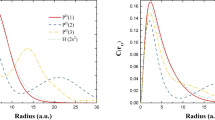Abstract
High-lying doubly excited states of He and H− are studied and energies and intrinsic characteristics of their wave-functions are reported. Results for energies of 3Po and 1D doubly excited states associated with the hydrogenic thresholds up to N = 20 are presented and compared to available data from the literature. The classification of these doubly excited states by approximate quantum numbers is reexamined.
Similar content being viewed by others
References
D.R. Herrick: “New symmetry properties of atoms and molecules”, Adv. Chem. Phys., Vol. 52, (1983), pp. 1–115.
U. Fano: “Correlations of two excited electrons”: Rep. Prog. Phys., Vol. 46, (1983), pp. 97–165.
F.H. Read: “A New Class of Atomic States: The ‘Wannier-ridge’ Resonances”, Aust. J. Phys., Vol. 35, (1982), pp. 475–499.
C.D. Lin: “Doubly excited states, including new classification schemes,”Adv. At. Mol. Phys., Vol. 22, (1986), pp. 77–142.
A.R.P. Rau: “Group theoretical treatments of strongly correlated atomic dynamics,”Rep. Prog. Phys., Vol. 53, (1990), pp. 181–220.
J.M. Rost and J.S. Briggs: “Saddle structure of the three-body Coulomb problem; symmetries of doubly-excited states and propensity rules for transitions,”J. Phys. B: At. Mol. Opt. Phys., Vol. 24, (1991), pp. 4293–4322.
B. Gremaud and D. Delande: “Photo-ionization of the helium atom close to the double-ionization threshold: Towards the Ericson regime,”Europhys. Lett., Vol. 40, (1997), pp. 363–368.
J.S. Briggs: “The Dynamics of Two-electron Atoms,”Aust. J. Phys., Vol. 52, (1999), pp. 341–349.
G. Tanner, K. Richter and J.M. Rost: “The theory of two-electron atoms: between ground state and complete fragmentation,”Rev. Mod. Phys., Vol. 72, (2000), pp. 497–544.
J.W. Cooper, U. Fano and F. Prats: “Classification of two-electron excitation levels of helium,”Phys. Rev. Letters, Vol. 10, (1963), pp. 518–521.
S.I. Themelis, Y. Komninos and C.A. Nicolaides: “Properties of doubly excited states of H− and He associated with the manifolds from N=6 up to N=25,”Eur. Phys. J. D, Vol. 18, (2002), pp. 277–293.
Y. Komninos, S.I. Themelis, M. Chrysos and C.A. Nicolaides: “Properties of the Two-Electron Ionization Ladder and Related Good Quantum Numbers,”Int. J. Qu. Chem., Vol. S27, (1993), pp. 399–406.
S.I. Themelis and C.A. Nicolaides: “Partial widths with interchannel coupling to all orders for the H− two-electron ionizatrion ladder of1D symmetry,”Phys. Rev. A, Vol. 49, (1994), pp. 596–598.
S.I. Themelis and C.A. Nicolaides: “Energies, widths and l-dependence of the H− 3P and He− 4P TEIL states,”J. Phys. B.: At. Mol. Opt. Phys., Vol. 28, (1995), pp. L379–L385.
D.R. Herrick and O. Sinanoğlu: “Comparison of doubly-excited helium energy levels, and group-theoretical configuration-mixing predictions with large-configuration-interaction calculations and experimental spectra,”Phys. Rev. A, Vol. 11, (1975), pp. 97–110.
O. Sinanoğlu and D.R. Herrick: “Group theoretic prediction of configuration mixing effects due to Coulomb repulsions in atoms with applications to doubly-excited spectra,”J. Chem. Phys., Vol. 62, (1975), pp. 886–892.
C.E. Wulfman: “Approximate dynamical symmetry of two-electron atoms,”Chem. Phys. Lett., Vol. 23, (1973), pp. 370–372.
J.M. Feagin and J.S. Briggs: “Molecular Description of Two-Electron Atoms,”Phys. Rev. Lett., Vol. 57, (1986), pp. 984–987.
K. Mølmer and K. Taulbjerg: “Geometrical interpretation of doubly excited states,”J. Phys. B: At. Mol. Phys., Vol. 21, (1988), pp. 1739–1749.
J.-M. Rost, R. Gersbacher, K. Richter, J.S. Briggs and D. Wingten, “The nodal structure of doubly-excited resonant states of helium,”J. Phys. B: At. Mol. Opt. Phys., Vol. 24, (1991), pp. 2455–2466.
G.S. Ezra and R.S. Berry: “Classification of Doubly Excited States of Two-Electron Atoms,”Phys. Rev. Letters, Vol. 52, (1984), pp. 1252.
H.R. Sadeghpour: “Nonadiabatic selection rules for the photoabsorption of H− and He,”Phys. Rev. A., Vol. 43, (1991), pp. 5821–5831.
E.A. Gerasimovich, I.K. Dmitrieva and G.I. Plindov: “Propensity rules for radiative rates of high-lying doubly excited states of multiply charged helium-like ions,”J. Phys. B: At. Mol. Opt. Phys., Vol. 29, (1996), pp. 5227–5235.
A. Vollweiter, J.-M. Rost and J.S. Briggs: “Saddle dynamics of intrashell resonances: propensity rules for radiative transitions,”J. Phys. B: At. Mol. Opt. Phys., Vol. 24 (1991), pp. L155–L159.
L. Lipsky, R. Anania and M.J. Connely: “Energy levels and classifications of doubly-excited states in two-electron systems with nuclear charge, Z=1,2,3,4,5, below the N = 2 and N = 3 thresholds,”At. Data Nucl. Data Tables, Vol. 20, (1977), pp. 127–141.
O. Robaux: “Correlations in the1 P o levels of doubly excited helium below the He+ (N≤5) ionisation thresholds,”J. Phys. B: At. Mol. Phys., Vol. 20, (1987), pp. 2347–2357.
H. Bachau: “Correlations in the doubly excited states of O6+ (3l,nl′) with n = 3,4”, J. Phys. B: At. Mol. Phys., Vol. 21, (1988), pp. 3547–3558.
T.F. O’Malley and S. Geltman: “Compound-Atom States for Two-Electron Systems,”Phys. Rev., Vol. 137, (1965), pp. A1344-A1352.
Y. Komninos and C.A. Nicolaides: “The Wannier two-electron ionisation ladder in many-electron systems: the He1Po doubly excited states,”J. Phys. B: At. Mol. Phys., Vol. 19, (1986), pp. 1701–1711.
T. Koga and H. Matsuyama: “Interelectronic angle densities of equivalent electrons in Hartree-Fock theory of atoms,”J. Chem. Phys., Vol. 120, (2004), pp. 7831–7836.
Y.K. Ho: “P-wave doubly excited resonances in He,”J. Phys. B: At. Mol. Phys., Vol. 15, (1982), pp. L691–L695.
Y.K. Ho and J. Callaway: “Resonances in H− associated with the N = 4, 5, and 6 hydrogen thresholds,”Phys. Rev. A, Vol. 34, (1986), pp. 130–137.
M. Bylicki and C.A. Nicolaides: “Theoretical resolution of the H− resonance spectrum up to the n = 5 threshold: States of3Po symmetry,”Phys. Rev. A, Vol. 65, (2001), pp. 012504.
A.S. Ndao, A. Wagué, N.A.B. Faye and A. Konte: “High-lying1,3Po resonance states of He (n=4) and H− (n=5),”Eur. Phys. J.D., Vol. 5, (1999), pp. 327–334.
Y.K. Ho: “Resonances in H− associated with the N = 7 hydrogen threshold,”Phys. Rev. A., Vol. 41, (1990), pp. 1492–1495.
J.-M. Rost, K. Schulz, M. Domcke and G. Kaindl: “Resonance parameters of photo doubly excited helium,”J. Phys. B: At. Mol. Opt. Phys., Vol. 30, (1997), pp. 4663–4694.
Author information
Authors and Affiliations
About this article
Cite this article
Themelis, S.I. High-lying doubly excited states of He and H−: electron correlations and classification schemes. centr.eur.j.phys. 3, 324–338 (2005). https://doi.org/10.2478/BF02475641
Received:
Accepted:
Issue Date:
DOI: https://doi.org/10.2478/BF02475641




